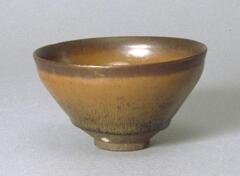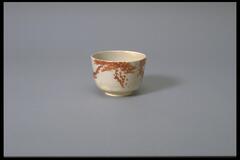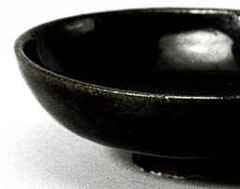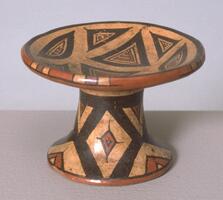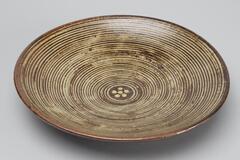72 Items in this Learning Collection
Collection Object
Collection Object
Collection Object
Collection Object
Collection Object
Collection Object
Collection Object
Collection Object
Collection Object
Collection Object
Collection Object
Collection Object
Collection Object
Collection Object
Collection Object
Collection Object
Collection Object
Collection Object
Collection Object
Collection Object
Collection Object
Collection Object
Collection Object
Collection Object
Collection Object
Collection Object
Collection Object
Collection Object
Collection Object
Collection Object
Collection Object
Collection Object
Collection Object
Collection Object
Collection Object
Collection Object
Collection Object
Collection Object
Collection Object
Collection Object
Resource with 15 media
Collection Object
Copyright
All Rights Reserved
()
Mashiko Ware Teacup (style of Hamada Shôji)
Accession Number
2003/2.18
Title
Mashiko Ware Teacup (style of Hamada Shôji)
Artist(s)
Old Mashiko Ware
Object Creation Date
circa 1950-1960
Medium & Support
stoneware with underglaze iron painting and translucent glaze
Dimensions
4 in. x 3 3/4 in. x 3 3/4 in. ( 10.1 cm x 9.5 cm x 9.5 cm )
Credit Line
Gift of Mr. and Mrs. Stephen H. Spurr
Label copy
In 1924, Hamada Shôji moved to the town of Mashiko, a folk pottery center about two hours from central Tokyo. After studying in Kyoto and England, he was intent on creating ceramics in this renowned rural kiln where over a period of hundreds of years, pots and other wares had been produced for everyday use. At first the young, educated potter was not welcomed by the community, but gradually he became part of it, and Mashiko’s rough clay, dark brown glaze made from local stones, and simple drawing style became essential elements of his work.
The Mingei movement expanded both nationally and internationally during the postwar period as the reputations of its major artists grew. Hamada and fellow-potter Kawai, the textile artist Serizawa Keisuke (1895–1984), and the printmaker Munakata Shikô (1903–1975) exhibited their work widely and won prizes at international art competitions. As a result, traditional folk pottery by anonymous potters began to be valued and collected. The movement also inspired a younger generation of studio potters, including Tamura Kôichi and Ôta Kumao, who created strikingly modern works using the traditional forms of folk pottery as a point of departure.
(Turning Point exhibition, Spring 2010)
Subject matter
Tea bowl for tea or ceremony.
Physical Description
Stoneware tea bowl with short foot that flares out into the base of the tea bowl, and bends gently back inwards, until flaring slightly at the lip of the piece. Underglaze design of a circle and stylized design or plant decorates the side of the bowl.
Primary Object Classification
Ceramic
Primary Object Type
cup
Additional Object Classification(s)
Decorative Arts
Collection Area
Asian
Rights
If you are interested in using an image for a publication, please visit http://umma.umich.edu/request-image for more information and to fill out the online Image Rights and Reproductions Request Form.
Keywords
cups (drinking vessels)
tea (beverage)
tea bowls
2003/2.18
Title
Mashiko Ware Teacup (style of Hamada Shôji)
Artist(s)
Old Mashiko Ware
Object Creation Date
circa 1950-1960
Medium & Support
stoneware with underglaze iron painting and translucent glaze
Dimensions
4 in. x 3 3/4 in. x 3 3/4 in. ( 10.1 cm x 9.5 cm x 9.5 cm )
Credit Line
Gift of Mr. and Mrs. Stephen H. Spurr
Label copy
In 1924, Hamada Shôji moved to the town of Mashiko, a folk pottery center about two hours from central Tokyo. After studying in Kyoto and England, he was intent on creating ceramics in this renowned rural kiln where over a period of hundreds of years, pots and other wares had been produced for everyday use. At first the young, educated potter was not welcomed by the community, but gradually he became part of it, and Mashiko’s rough clay, dark brown glaze made from local stones, and simple drawing style became essential elements of his work.
The Mingei movement expanded both nationally and internationally during the postwar period as the reputations of its major artists grew. Hamada and fellow-potter Kawai, the textile artist Serizawa Keisuke (1895–1984), and the printmaker Munakata Shikô (1903–1975) exhibited their work widely and won prizes at international art competitions. As a result, traditional folk pottery by anonymous potters began to be valued and collected. The movement also inspired a younger generation of studio potters, including Tamura Kôichi and Ôta Kumao, who created strikingly modern works using the traditional forms of folk pottery as a point of departure.
(Turning Point exhibition, Spring 2010)
Subject matter
Tea bowl for tea or ceremony.
Physical Description
Stoneware tea bowl with short foot that flares out into the base of the tea bowl, and bends gently back inwards, until flaring slightly at the lip of the piece. Underglaze design of a circle and stylized design or plant decorates the side of the bowl.
Primary Object Classification
Ceramic
Primary Object Type
cup
Additional Object Classification(s)
Decorative Arts
Collection Area
Asian
Rights
If you are interested in using an image for a publication, please visit http://umma.umich.edu/request-image for more information and to fill out the online Image Rights and Reproductions Request Form.
Keywords
cups (drinking vessels)
tea (beverage)
tea bowls
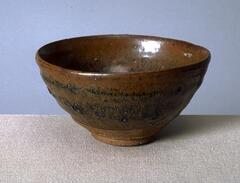
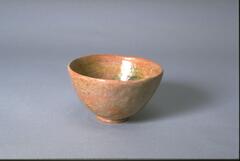
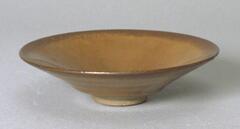
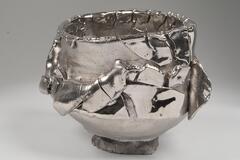
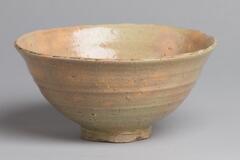
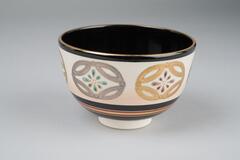
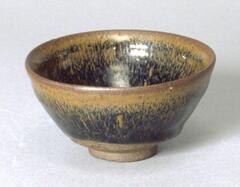
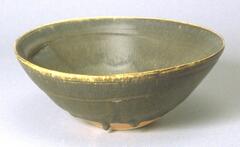

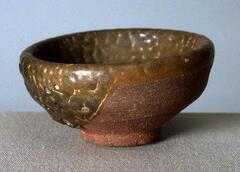
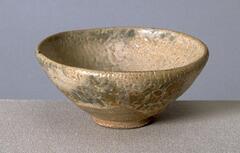
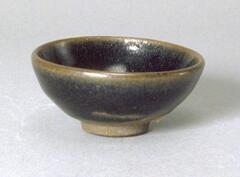
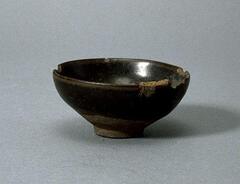
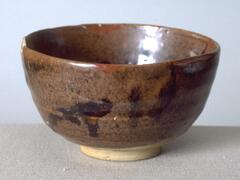
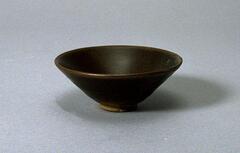
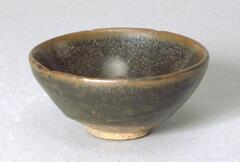

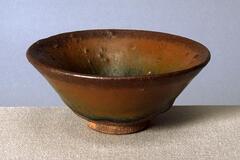
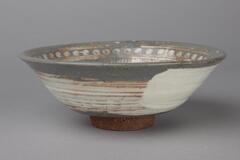
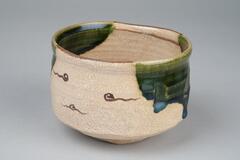
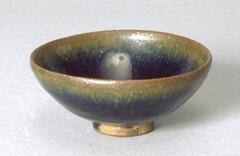


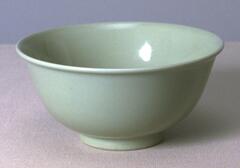

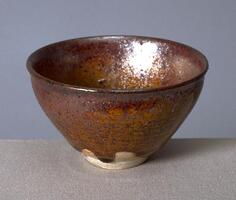
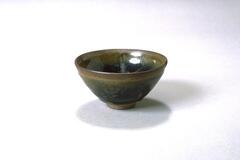

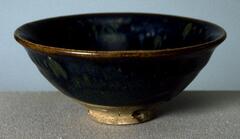
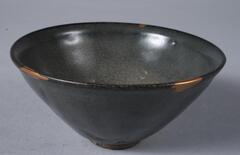
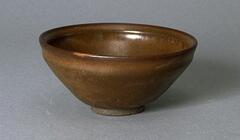
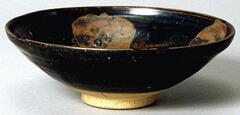
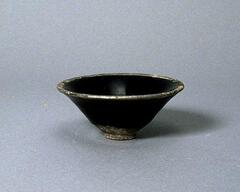
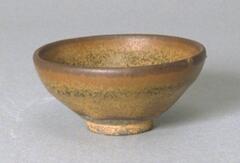
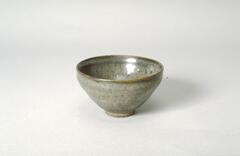

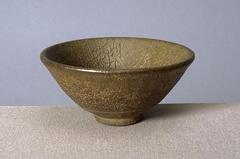
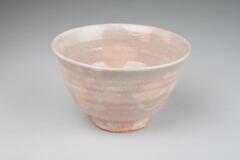
![Stoneware bowl with stamped rope-curtain design covered by a white slip and colorless glaze. A stylized inlaid chrysanthemum blossom decorates the center of the bowl, surrounded by a band of petals.<br />
<br />
This buncheong bowl with stamped design was maily supplied to government offices in the 15th century. It is decorated with a lotus flower on the inner base surrounded by lotus petals, butterflies and rows of dots on the inner wall. The outer wall, too, is filled with rows of dots. It was poorly sintered and the glaze applied to the lower part of the body is not melted in parts. The foot is not glazed and exposes the clay body.<br />
[Korean Collection, University of Michigan Museum of Art (2014) p.147] Stoneware bowl with stamped rope-curtain design covered by a white slip and colorless glaze. A stylized inlaid chrysanthemum blossom decorates the center of the bowl, surrounded by a band of petals.<br />
<br />
This buncheong bowl with stamped design was maily supplied to government offices in the 15th century. It is decorated with a lotus flower on the inner base surrounded by lotus petals, butterflies and rows of dots on the inner wall. The outer wall, too, is filled with rows of dots. It was poorly sintered and the glaze applied to the lower part of the body is not melted in parts. The foot is not glazed and exposes the clay body.<br />
[Korean Collection, University of Michigan Museum of Art (2014) p.147]](/media/W1siZiIsIjIwMjIvMDkvMjQvOWRtNDIyZTcyX2RlZmF1bHQuanBnIl0sWyJwIiwidGh1bWIiLCIyNDB4MjAwIl1d?sha=0b90e10dcc5f13d1)

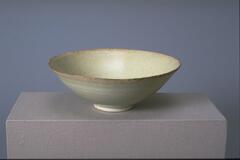
![<p>This is an undecorated bowl with diagonally flaring out sides. On the outer base and rim of the foot remain traces of refractory spur marks. The bowl was oxidized in the kiln, producing a green-brown hue, while the interior contains large bubbles. The color of its glaze is similar to that of other vessels excavated from sedimentary layers of refuse pile at celadon kilns in Goyang-si, Gyeonggi-do.<br />
[<em>Korean Collection, University of Michigan Museum of Art </em>(2014) p.101]</p>
<br />
It has an outwardly flared rim and steep side. A yellow brownish glaze is applied. The clay contains some impurities and the foot is relatively high. There is four spur-marks on the interior. <p>This is an undecorated bowl with diagonally flaring out sides. On the outer base and rim of the foot remain traces of refractory spur marks. The bowl was oxidized in the kiln, producing a green-brown hue, while the interior contains large bubbles. The color of its glaze is similar to that of other vessels excavated from sedimentary layers of refuse pile at celadon kilns in Goyang-si, Gyeonggi-do.<br />
[<em>Korean Collection, University of Michigan Museum of Art </em>(2014) p.101]</p>
<br />
It has an outwardly flared rim and steep side. A yellow brownish glaze is applied. The clay contains some impurities and the foot is relatively high. There is four spur-marks on the interior.](/media/W1siZiIsIjIwMjIvMDUvMjUvMnhtbDducjBocl9kZWZhdWx0LmpwZyJdLFsicCIsInRodW1iIiwiMjQweDIwMCJdXQ?sha=ab0ce1dba1be4d21)
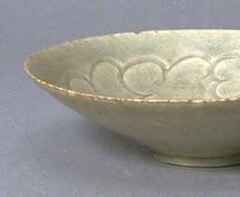
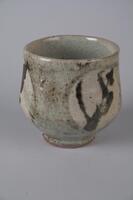
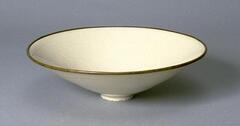
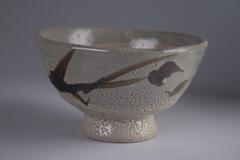
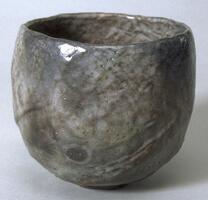

![Stoneware tea bowl with slightly flaring lip, white slip hakame design and colorless glaze.<br />
<br />
The inner and outer surfaces of this buncheong bowl have been brushed with white slip. Its inner base retains traces of seven spurs, while the uneven application of glaze has exposed the unglazed body. The glaze itself was fairly well fused. The bowl is intact without damage.<br />
[Korean Collection, University of Michigan Museum of Art (2014) p.156] Stoneware tea bowl with slightly flaring lip, white slip hakame design and colorless glaze.<br />
<br />
The inner and outer surfaces of this buncheong bowl have been brushed with white slip. Its inner base retains traces of seven spurs, while the uneven application of glaze has exposed the unglazed body. The glaze itself was fairly well fused. The bowl is intact without damage.<br />
[Korean Collection, University of Michigan Museum of Art (2014) p.156]](/media/W1siZiIsIjIwMjIvMDkvMjQvNm9xY20waHdlX2RlZmF1bHQuanBnIl0sWyJwIiwidGh1bWIiLCIyNDB4MjAwIl1d?sha=36b91ee5facf512c)
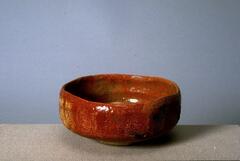
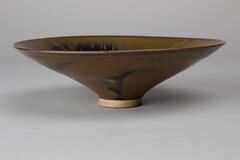
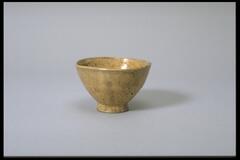
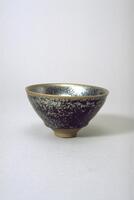

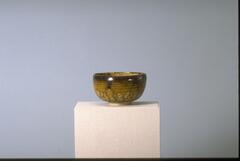
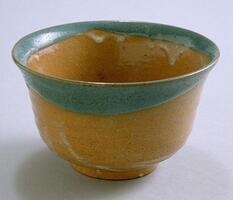




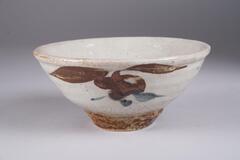
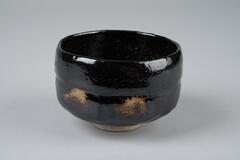
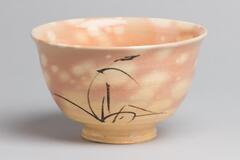

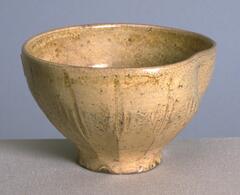
![<p>This bowl exemplifies early-tenth century celadon forms influenced by Chinese Yue ware. It has a halo-shaped foot (haemurigup), a characteristic of Yue ware. It is a high-quality celadon made from fine clay, coated by highly transparent glaze. Surface is plain while displaying crackles on its inner surface and parts of its outer surface. Many similar vessels were excavated from the Kilns no. 9 and no. 10 at Yongun-ri, Gangjin-gun, Jeollanam-do. Refractory spur marks created during firing remain in five places on the rim of the foot.<br />
[<i>Korean Collection, University of Michigan Museum of Art </i>(2014) p.88]</p>
Stoneware tea bowl with celadon glaze. <p>This bowl exemplifies early-tenth century celadon forms influenced by Chinese Yue ware. It has a halo-shaped foot (haemurigup), a characteristic of Yue ware. It is a high-quality celadon made from fine clay, coated by highly transparent glaze. Surface is plain while displaying crackles on its inner surface and parts of its outer surface. Many similar vessels were excavated from the Kilns no. 9 and no. 10 at Yongun-ri, Gangjin-gun, Jeollanam-do. Refractory spur marks created during firing remain in five places on the rim of the foot.<br />
[<i>Korean Collection, University of Michigan Museum of Art </i>(2014) p.88]</p>
Stoneware tea bowl with celadon glaze.](/media/W1siZiIsIjIwMjIvMDkvMjQvMXB2aXlzcnZpZF9kZWZhdWx0LmpwZyJdLFsicCIsInRodW1iIiwiMjQweDIwMCJdXQ?sha=7ddc9c1585910d07)

